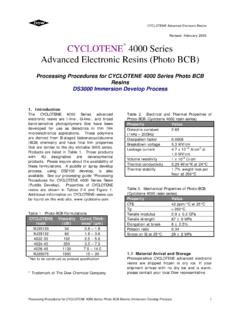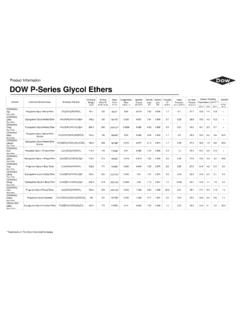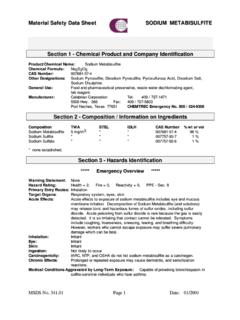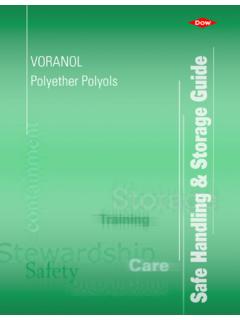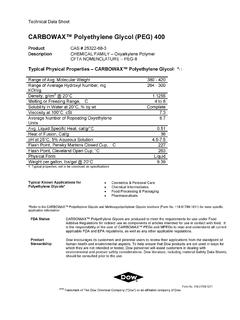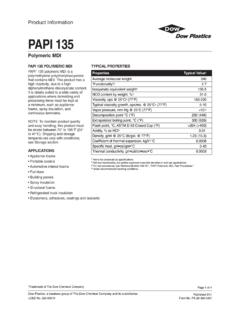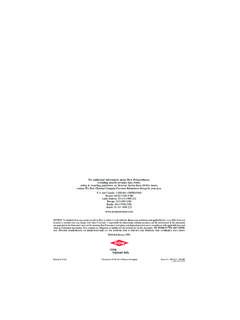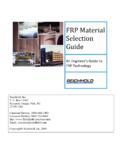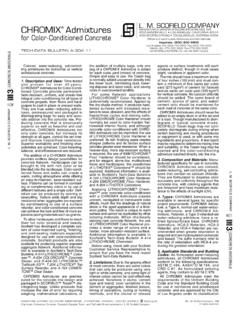Transcription of A Guide to Glycols - msdssearch.dow.com
1 A Guide to GlycolsFull Table of ContentsDow s Propylene GlycolsChemistry of GlycolsPhysical PropertiesApplications and UsesFood Additive StatusToxicological and Environmental ConsiderationsQuality and Product SpecificationsStorage of GlycolsMaterial CompatibilityAppendixIndexA Guide to GlycolsDow Propylene Glycols .. 3 The Versatile Performers .. 3 Chemistry of Glycols .. 4 Physical Properties .. 7 Physical Properties Summary .. 7 Table: Physical Properties of Glycols .. 7 Freezing Point .. 9 Burst Protection .. 9 Solubility .. 10 Hygroscopicity and Humectancy .. 13 Dehydration of Gases .. 14 Vapor Pressure and Boiling Point .. 15 Viscosity .. 18 Specific Heat .. 21 Density .. 22 Surface Tension .. 25 Air Contact and Flammability .. 26 Refractive Index .. 27 Applications and Uses .. 28 Propylene Glycol (Monopropylene glycol).
2 28 Dipropylene Glycol .. 28 Tripropylene Glycol .. 30 Food Additive Status .. 31 NOTE TO CUSTOMERS CONCERNING FOOD ADDITIVE STATUS .. 31 Propylene Glycol .. Regulations .. 31 Direct applications .. 31 Indirect applications .. 32 European Regulations .. 33 Direct applications .. 33 Indirect applications .. 33 Dipropylene Glycol .. Regulations .. 33 Direct applications .. 33 Indirect applications .. 33 European Regulations .. 34 Direct applications .. 34 Indirect applications .. 34 Tripropylene Glycol .. Regulations .. 34 Direct applications .. 34 Indirect applications .. 34 European Regulations .. 34 Direct applications .. 34 Indirect applications.
3 34 Toxicological and Environmental Considerations .. 35 Quality and Product Specifications .. 37 Storage of Glycols .. 38 Material Compatibility .. 41 Appendix .. 42 Conversion Charts for Weight to Volume Calculations .. 42 Temperature Conversion Chart .. 43 Index .. 44 2003, The Dow Chemical Company, All rights reserved2A Guide to Glycols3 Propylene Glycols from DowThe Versitile Performers Antifreeze/Coolant Formulations Heat Transfer Fluids Solvents Food Flavors and Fragrances Cosmetics and Personal Care Products Pharmaceuticals Chemical Intermediates Hydraulic Fluids Plasticizers Resin Formulations Gas Dehydration OperationsPropylene Glycols ( Glycols ) play a significant role in industry due to their wide range of practical applications. Glycols are found in such diverse products and applications as thermoset plastics, clothing, latex paints, glass and enamel surface cleaners, automotive antifreeze/coolants, heat transfer fluids, aircraft deicing fluids, natural gas treatment, chemical process fluids, hydraulic fluids, paper and packaging, adhesives, plasticizers, pesticides, printing inks, cosmetics, pharmaceuticals, foods and electronics.
4 All of these applications utilize propylene Glycols , either as an integral part of the product or as a facilitator in their s expertise, conscientious regulatory compliance, quality control in production, extensive distribution network, and dedicated customer service makes Dow s Glycols the preferred glycol products of industry. Dow offers the following quality products in its PROPYLENE GLYCOL group:Propylene Glycol USP/EP (PG USP/EP)Propylene Glycol Industrial (PGI)Dipropylene Glycol (DPG)Dipropylene Glycol LO+ (DPG LO+)Tripropylene Glycol (TPG)Tripropylene Glycol Acrylate Grade (TPG Ac)Please visit to obtain more information about Dow s Glycols product offering, such as Technical Datasheets (TDS), Material Safety Datasheets (MSDS or SDS) and sales Guide to Glycols4 The structural formulas of the propylene Glycols commercially produced by Dow are: Propylene Glycol Dipropylene Glycol1 Tripropylene Glycol1 Propylene Glycols ( Glycols ) chemistry centers on the two hydroxyl (OH) groups that characterize them as Glycols .
5 They, therefore, have intermediate properties between alcohols, with a single hydroxyl group and glycerine with its three hydroxyl groups. Likewise, the solubility characteristics of Glycols tend to be between those of the simple alcohols and are normally quite stable under normal storage conditions, but can oxidize in the presence of air, particularly when heated. This gives rise to oxidation products such as carbonyl compounds and acids. The effects of such degradation can be controlled by the use of stabilizers, to the extent that these Glycols can be used as heat transfer media at relatively high suitable dehydrating conditions, Glycols can split out water in the following ways: 1. One molecule of water from one molecule of glycol to form aldehydes One molecule of water from two molecules of glycol to form a of Glycols1 And other isomersA Guide to Glycols53.
6 Two molecules of water from two molecules of glycol to form cyclic can be a stepwise reaction with dipropylene glycol (DPG) as the The hydrogens in either or both of the hydroxyl groups can be replaced by an alkali metal, either by direct reaction or by splitting out water from the corresponding alkali metal and Glycols readily form mono- and diesters by reaction with acids, acid halides or acid anhydrides. Below, this reaction is illustrated using an Unsaturated polyester resins (UPR) are synthesized by the stepwise stoichiometric polycondensation reactions between various ratios of saturated and unsaturated dicarboxylic acids or their anhydrides with Glycols or polyols. Propylene glycol is used extensively in these systems. The unsaturated dicarboxylic acid is typically maleic or fumeric acid and the saturated dicarboxylic acid is phthalic or isophthalic acid.
7 Other Glycols are also used but monopropylene glycol is the most typically used. larger viewA Guide to Glycols67. After synthesis of the unsaturated polyester, the unsaturated acid functionality is used to react with an unsaturated monomer, such as styrene, to crosslink and cure the resin using vinyl Guide to Glycols7 Propylene Glycols ( Glycols ) are liquids with high boiling and low freezing points, which permit volume storage in a wide range of climates, usually without special insulation or heating requirements. Vent losses are minimal since their vapor pressures are relatively low, and Glycols are easily pumped and metered in industrial are aliphatic organic compounds having two hydroxyl groups per molecule. Glycols resemble water in that they are essentially clear, colorless liquids with practically no odor. Glycols are excellent solvents for many organic compounds and are completely water-soluble.
8 Since they can undergo chemical reactions on one or both hydroxyl groups, they are important as chemical chemistry and properties of Dow s Glycols are so wide-ranging, you may need assistance in determining how a particular glycol can be used and under what conditions it should be applied. Dow can help you by supplying the necessary information for their proper application. This product application support is part of the service Dow provides for its family of produces a series of propylene Glycols as well as a series of polypropylene Glycols (PPGs). We welcome inquiries on these or any other propylene oxide derivatives in which you may have interest, though this publication is focused on mono, di and tripropylene Glycols . For more information, please visit The Dow Chemical Company or the Propylene Oxide web sitesPhysical Properties SummaryPhysical Properties* of GlycolsPhysical PropertiesUnitsPropylene GlycolDipropylene GlycolTripropylene GlycolChemical Name1,2-propanedioloxybispropanol[(1-met hyl-1,2-ethanediyl)bis(oxy)] bispropanolFormulaC3H8O2C6H14O3C9H20O4 CAS Number157-55-625265-71-824800-44-0 EINECS Number200-338-0246-770-3246-466-0 Molecular Point760 mm Hg, mm Hg, Pressure mm Hg, 77 F (25 C) Rate(n-Butyl Acetate = 1) *Note: These properties are laboratory results on pure compounds or are typical of the product.
9 Typical properties should not be confused with, or regarded as, specifications.**Electrical conductivity values are measured on pure materials. Contamination by other ionic species from storage, handling or use, may significantly affect electrical conductivity. 1 Chemical Abstract Service Numbercontinued >A Guide to Glycols8< backPhysical PropertiesUnitsPropylene GlycolDipropylene GlycolTripropylene GlycolDensity g/cm3, 77 F(25 C) , 140 F (60 C) , 77 F (25 C) Point F ( C)SupercoolsSupercoolsSupercoolsPour Point F<-71-38-42 C<-57-39-41 Viscosity Centipoise (mPas), 77 F (25 C) (mPas), 140 F (60 C) Tension dynes/cm (mN/m), 77 F (25 C)363534 Refractive Index at 77 F (25 C) Heat Btu/lb/ F, 77 , 25 Point F ( C) (104) (124) (143)Dipole Moment of Expansion (0-60 C) Conductivity Btu hr-1 ft-1 F-1, 77 F (25 C) *K, 25 of Formation Kcal/g-mol-101-150-199KJ/mol-422-628-831 Heat of Vaporization Btu/lb, 77 F (25 C)379257200KJ/mol, 25 Value1470836584 Electrical Conductivity mhos/cm (S/cm), 25 C** < *Note: These properties are laboratory results on pure compounds or are typical of the product.
10 Typical properties should not be confused with, or regarded as, specifications.**Electrical conductivity values are measured on pure materials. Contamination by other ionic species from storage, handling or use, may significantly affect electrical conductivity. 1 Chemical Abstract Service NumberA Guide to Glycols9 Specific Physical Properties Freezing PointWhen liquids are cooled they eventually either crystallize like ice or become increasingly viscous until they fail to flow and set up like glass. The first type of behavior represents true freezing. The second is known as super-cooling. Glycols do not have sharp freezing points. Under normal conditions, propylene glycol and its homologs set to glass-like solids, rather than addition of water to a glycol yields a solution with a freezing point below that of water. This has led to the extensive use of glycol-water solutions as cooling media at temperatures appreciably below the freezing point of water.
